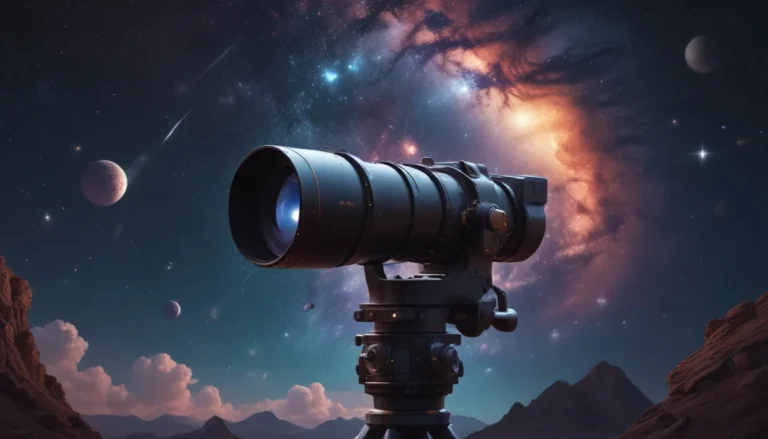The pictures we use in our articles might not show exactly what the words say. We choose these pictures to make you interested in reading more. The pictures work together with the words but don’t take their place. The words still tell you the important facts.
Exploring the vast expanse of space has always been a source of wonder and inspiration for humanity. From setting foot on the moon to venturing out to distant planets, space missions have pushed the boundaries of human achievement and expanded our understanding of the cosmos. In this article, we will embark on a cosmic journey to uncover 17 enigmatic facts about space missions that will leave you in awe of the incredible feats accomplished by astronauts and space agencies. Get ready to delve into the fascinating world of space exploration and discover the marvels of outer space!
Unveiling the Wonders of Space Missions
Space missions have achieved incredible milestones, from walking on the moon to exploring the outer reaches of our solar system. These missions showcase the ambition and determination of human exploration in outer space, inspiring us to push the boundaries of knowledge and discovery. Let's explore some of the most intriguing facts about space missions that will leave you mesmerized by the wonders of the universe.
Neil Armstrong’s Iconic Moonwalk
Neil Armstrong's historic moonwalk on July 20, 1969, during the Apollo 11 mission, marked a monumental moment in human history. His famous words, "That's one small step for man, one giant leap for mankind," still resonate today as a testament to the ambition and determination of space missions.
Voyager Spacecraft: Beyond the Solar System
The Voyager spacecrafts, launched in 1977, embarked on an interstellar journey, becoming the first man-made objects to leave the solar system. Voyager 1 and Voyager 2 have provided invaluable data about the outer planets of our solar system, crossing the heliopause and entering interstellar space, revealing fascinating insights about the cosmic environment beyond our solar system.
The Revolutionary Hubble Space Telescope
Launched in 1990, the Hubble Space Telescope has revolutionized our understanding of the universe. Through breathtaking images and groundbreaking discoveries, the Hubble has reshaped our knowledge of space, providing unprecedented views of nebulae, galaxies, and cosmic phenomena.
The International Space Station: A Symbol of Human Exploration
The International Space Station (ISS) holds the record for the longest continuous human presence in space since November 2000. Serving as a home and laboratory for astronauts from various countries, the ISS enables scientific research, technological advancements, and international collaboration, paving the way for long-duration space missions and future human exploration of other planets.
Mars Rovers: Exploring the Red Planet
Mission after mission, rovers like Spirit, Opportunity, and Curiosity have significantly expanded our knowledge of Mars. By exploring the Martian surface, analyzing soil samples, and detecting signs of liquid water, these robotic explorers have provided valuable insights into the geology and potential for life on Mars.
Valentina Tereshkova: Trailblazer in Space Exploration
Valentina Tereshkova, a Soviet cosmonaut, made history as the first woman to travel to space in 1963. Her mission aboard Vostok 6 inspired generations of female astronauts, opening doors for women to contribute to the advancement of space science.
Parker Solar Probe: The Fastest Human-Made Object
Launched in 2018, the Parker Solar Probe is designed to study the Sun's outer atmosphere and its effects on space weather. Reaching speeds of up to 430,000 miles per hour, it holds the record as the fastest object ever created by humanity.
Dennis Tito: The First Space Tourist
In 2001, Dennis Tito became the first non-astronaut to travel to space, kickstarting the era of space tourism. By joining a Russian Soyuz mission to the ISS, Tito paved the way for private citizens to experience the wonders of space firsthand.
New Horizons Mission: Revealing Pluto’s Secrets
The New Horizons mission provided the first detailed images of Pluto in 2015. By capturing close-up images of this dwarf planet, revealing icy mountains and nitrogen glaciers, the mission shed light on the mysteries of the distant reaches of our solar system.
Extraordinary Spacewalks
During the STS-102 mission in 2001, astronauts Jim Voss and Susan Helms set a record for the longest spacewalk, lasting nearly nine hours. This challenging feat demonstrates the endurance, courage, and technical skill required by astronauts during extravehicular activities.
Cassini-Huygens Mission to Saturn
Launched in 1997, the Cassini-Huygens spacecraft explored Saturn and its moons, providing remarkable insights into the Saturnian system. The mission revealed intricate details of Saturn's rings, discovered new moons, and landed a probe on Titan, expanding our understanding of the outer planets and their moons.
Salyut 1: The First Space Station
Salyut 1, launched by the Soviet Union in 1971, marked the beginning of permanent human habitation in space. Serving as an experimental platform for scientific research, Salyut 1 laid the foundation for future space stations like the ISS.
The Great Observatories: Transforming Astronomy
The Great Observatories – Hubble, Chandra, Spitzer, and Compton – have revolutionized astronomy by exploring different wavelengths of light. These space-based observatories have provided complementary data and observations that have deepened our understanding of the universe.
Space Shuttle Program: Introducing Reusable Spacecraft
The Space Shuttle program introduced the first reusable spacecraft, revolutionizing space travel. Iconic vehicles like Atlantis, Discovery, and Endeavour enabled the deployment of satellites, research in microgravity, and the construction of the ISS.
Rosetta Mission: Landing on a Comet
Launched in 2004, the Rosetta mission achieved the first-ever rendezvous and landing on a comet. By reaching comet 67P/Churyumov-Gerasimenko and deploying the Philae lander, the mission provided valuable data about comets and the early solar system.
Expedition 1 Crew: Pioneering Long-Duration Space Missions
The Expedition 1 crew, comprising American astronaut William Shepherd and Russian cosmonauts Yuri Gidzenko and Sergei Krikalev, marked the first long-duration stay on the ISS in 2000. This historic mission laid the groundwork for international cooperation in space and established the framework for future long-duration space missions.
Mars 2020 Mission: Perseverance in Exploration
The Mars 2020 mission, featuring the Perseverance rover and the Ingenuity helicopter, aims to search for signs of ancient life on Mars. This ongoing mission embodies humanity's relentless pursuit of knowledge and exploration, paving the way for future human missions to the Red Planet.
Conclusion: Unraveling the Mysteries of Space
Space missions continue to captivate our imaginations and push the boundaries of human exploration. From historic achievements like the Apollo moon landings to ongoing endeavors like the Mars 2020 mission, these ventures provide groundbreaking discoveries and valuable knowledge about the universe. As we look to the future, the enigmatic nature of space serves as a reminder of the endless mysteries waiting to be uncovered. Stay tuned for more exciting and awe-inspiring missions that will unlock the secrets of our cosmic neighborhood.
FAQs: Exploring the Universe
-
How long do space missions typically last?
Space missions vary in duration depending on their objectives. Some missions, like the Mars rovers, can last several years, while others, like the Apollo moon landings, were relatively short-lived, lasting only a few days. -
How do astronauts survive in space?
Astronauts survive in space by living aboard spacecraft or space stations equipped with life support systems that provide them with air, water, and food. Regular exercise helps combat muscle atrophy caused by microgravity. -
What is the biggest challenge of space missions?
One of the biggest challenges of space missions is the immense distances involved. Traveling to other celestial bodies in our solar system requires significant time and resources, making logistics and planning critical for mission success. -
How do space missions benefit us on Earth?
Space missions have led to advancements in technology, communication systems, weather forecasting, and medical practices. The knowledge gained from space exploration also enhances our understanding of Earth and its place in the universe. -
Are space missions dangerous?
Space missions come with inherent risks, including exposure to radiation, isolation, and physiological challenges. Extensive training, meticulous planning, and advanced technology help mitigate these risks and ensure the safety of astronauts.
The Thrill of Space Exploration
Space exploration continues to inspire and amaze us, offering a glimpse into the wonders of the universe. For those eager to learn more about the meticulous planning behind space missions, our article on space mission planning facts provides intriguing insights. If you're still enchanted by the moon landing, check out our Apollo 11 facts that will leave you over the moon. And for those curious about the challenges posed by space debris, our article on astonishing facts about space debris tracking systems sheds light on this critical aspect of space exploration.
Join Us in Exploring the Cosmic Frontier
Our dedication to delivering trustworthy and engaging content drives us to share fascinating facts and insights contributed by real users like you. Each fact undergoes meticulous review by our dedicated editors to ensure the highest standards of accuracy and reliability. Trust in our commitment to quality and authenticity as we embark on a journey of exploration and discovery together. Explore, learn, and marvel at the wonders of the universe with us!






